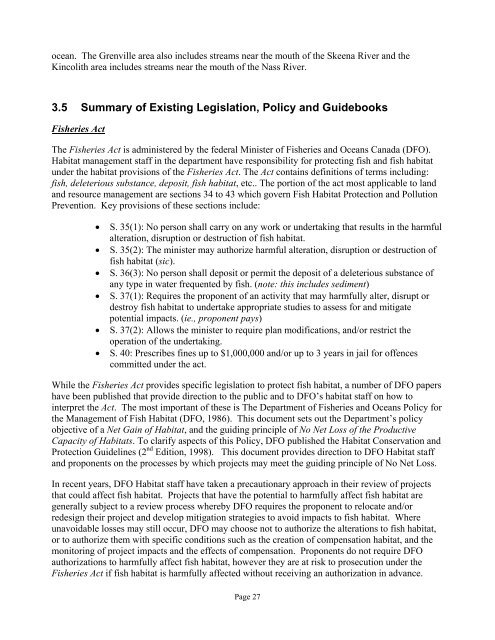Report Template - Ministry of Forests, Lands and Natural Resource ...
Report Template - Ministry of Forests, Lands and Natural Resource ...
Report Template - Ministry of Forests, Lands and Natural Resource ...
You also want an ePaper? Increase the reach of your titles
YUMPU automatically turns print PDFs into web optimized ePapers that Google loves.
ocean. The Grenville area also includes streams near the mouth <strong>of</strong> the Skeena River <strong>and</strong> the<br />
Kincolith area includes streams near the mouth <strong>of</strong> the Nass River.<br />
3.5 Summary <strong>of</strong> Existing Legislation, Policy <strong>and</strong> Guidebooks<br />
Fisheries Act<br />
The Fisheries Act is administered by the federal Minister <strong>of</strong> Fisheries <strong>and</strong> Oceans Canada (DFO).<br />
Habitat management staff in the department have responsibility for protecting fish <strong>and</strong> fish habitat<br />
under the habitat provisions <strong>of</strong> the Fisheries Act. The Act contains definitions <strong>of</strong> terms including:<br />
fish, deleterious substance, deposit, fish habitat, etc.. The portion <strong>of</strong> the act most applicable to l<strong>and</strong><br />
<strong>and</strong> resource management are sections 34 to 43 which govern Fish Habitat Protection <strong>and</strong> Pollution<br />
Prevention. Key provisions <strong>of</strong> these sections include:<br />
• S. 35(1): No person shall carry on any work or undertaking that results in the harmful<br />
alteration, disruption or destruction <strong>of</strong> fish habitat.<br />
• S. 35(2): The minister may authorize harmful alteration, disruption or destruction <strong>of</strong><br />
fish habitat (sic).<br />
• S. 36(3): No person shall deposit or permit the deposit <strong>of</strong> a deleterious substance <strong>of</strong><br />
any type in water frequented by fish. (note: this includes sediment)<br />
• S. 37(1): Requires the proponent <strong>of</strong> an activity that may harmfully alter, disrupt or<br />
destroy fish habitat to undertake appropriate studies to assess for <strong>and</strong> mitigate<br />
potential impacts. (ie., proponent pays)<br />
• S. 37(2): Allows the minister to require plan modifications, <strong>and</strong>/or restrict the<br />
operation <strong>of</strong> the undertaking.<br />
• S. 40: Prescribes fines up to $1,000,000 <strong>and</strong>/or up to 3 years in jail for <strong>of</strong>fences<br />
committed under the act.<br />
While the Fisheries Act provides specific legislation to protect fish habitat, a number <strong>of</strong> DFO papers<br />
have been published that provide direction to the public <strong>and</strong> to DFO’s habitat staff on how to<br />
interpret the Act. The most important <strong>of</strong> these is The Department <strong>of</strong> Fisheries <strong>and</strong> Oceans Policy for<br />
the Management <strong>of</strong> Fish Habitat (DFO, 1986). This document sets out the Department’s policy<br />
objective <strong>of</strong> a Net Gain <strong>of</strong> Habitat, <strong>and</strong> the guiding principle <strong>of</strong> No Net Loss <strong>of</strong> the Productive<br />
Capacity <strong>of</strong> Habitats. To clarify aspects <strong>of</strong> this Policy, DFO published the Habitat Conservation <strong>and</strong><br />
Protection Guidelines (2 nd Edition, 1998). This document provides direction to DFO Habitat staff<br />
<strong>and</strong> proponents on the processes by which projects may meet the guiding principle <strong>of</strong> No Net Loss.<br />
In recent years, DFO Habitat staff have taken a precautionary approach in their review <strong>of</strong> projects<br />
that could affect fish habitat. Projects that have the potential to harmfully affect fish habitat are<br />
generally subject to a review process whereby DFO requires the proponent to relocate <strong>and</strong>/or<br />
redesign their project <strong>and</strong> develop mitigation strategies to avoid impacts to fish habitat. Where<br />
unavoidable losses may still occur, DFO may choose not to authorize the alterations to fish habitat,<br />
or to authorize them with specific conditions such as the creation <strong>of</strong> compensation habitat, <strong>and</strong> the<br />
monitoring <strong>of</strong> project impacts <strong>and</strong> the effects <strong>of</strong> compensation. Proponents do not require DFO<br />
authorizations to harmfully affect fish habitat, however they are at risk to prosecution under the<br />
Fisheries Act if fish habitat is harmfully affected without receiving an authorization in advance.<br />
Page 27

















